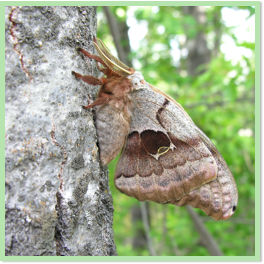
Giant Silk Moths
| By Doug Collicutt | (Click links for more images.) |
No, no, I'm not talking "Mothra" here. (You know . . . Mothra? Godzilla's fearsome foe? No? Yeesh, I guess I am getting old.) A giant silk moth around here is about the size of the palm of your hand. The biggest moth in the world is the size of two hands. But compared to most butterflies and moths, the silk moths are giants! They are also some of the most spectacular insects you will ever see.

A Polyphemus on a tree trunk.
Polyphemus . . . Luna . . . Columbia . . .Cecropia! No, that's not an ancient incantation, that's the holy grail of Manitoba's silk moths, the big 4! There's the Polyphemus moth (Antheraea polyphemus), the Luna (Actias luna), the Columbia silk moth (Hyalophora columbia) and the Cecropia (Hyalophora cecropia). Of these, the former two are very common and wide-spread throughout forested parts of southern and central Manitoba, while the latter two are found mainly in the southern part of the province and are down-right uncommon. All are greatly prized by lepidopterists for their size and great beauty. (If there's anybody up north who knows how far up the Luna and Polyphemus can be found, please let us know! The distribution of these two moths is not well known!)
Giant silk moths (Family: Saturniidae, Subfamily: Saturniinae, with 10 species in Canada and the United States) draw their collective name from the fine silk they use to spin their cocoons which serve as protection for the pupal stage in their life cycle. The commercial "silkworm" moth (Bombyx mori) is from a different family (Bombycidae).
The life cycle of a giant silk moth is pretty simple: hatch, eat, grow, pupate, emerge, mate, lay eggs, die; all in the span of one year. In late spring and early summer adult silk moths emerge from the cocoons where they have spent winter. In southern Manitoba the main emergence is usually sometime from mid-May to mid-June, later as you venture further north. (Further south, in the central and southern United States, silk moths may squeeze two life cycles into one year.) There is usually one period, several days to one week, within the late spring when most of the adults will emerge, though there will always be early-birds and stragglers. This synchrony is important in ensuring that males and females can find each other for mating. The first real warm spell of the year, when temperatures reach into the 20's C and nights stay warm for several days can trigger the main moth emergence.
Adults emerge from their cocoons in daytime, usually around mid-morning. This means they have the warmth of the day to inflate and dry their wings in preparation for the evening's flight. When darkness falls the moths begin their sole function: reproduction. Adult silk moths have no working mouth parts. They do not feed or drink and will only live for one to two weeks after emerging from their cocoons. Male moths seek out the females by scent. Females emit strong pheromones (chemical scents that trigger behaviours) and wait for the males to find them. The males' large comb-like antennae can detect the pheromone at minute concentrations.
The antennae of a male Polyphemus moth.
Once a female has mated and her eggs are fertilized, she takes flight, seeking out the appropriate plant species on which to deposit her eggs. Females can lay more than 100 eggs, but usually only place a few on any one suitable plant. Silk moth caterpillars, like those of most other butterflies and moths are adapted to feed on the leaves of only a few specific kinds of plants. The female moth must place her eggs on the right plant or the caterpillars will not survive. Females probably rely mainly on scent to locate the required plants. The larval host plants, caterpillar food, for Manitoba's silk moths are listed in our Guide to Manitoba's Giant Silk Moths. (You're on your way there.)
Eggs of a Polyphemus moth on a birch leaf.
The eggs will hatch in about 10-14 days and the tiny caterpillars begin a frenzy of eating. In just 5-8 weeks they can grow from 3 mm in length, at hatching, to as much as 70 - 100 mm. Over their short life as a caterpillar their body weight increases by a factor of more than 10,000! To accommodate this prodigious growth the caterpillars shed their skin, 4 times, passing through 5 larval stages, known as instars. (A third instar is a caterpillar that has shed its skin twice since hatching from the egg.)
|
By mid to late August the caterpillars have reached full size. They then embark on what might at first seem to be a peculiar journey. They crawl down from the tree or shrub where they have been feeding and go for a walk. At this time of year it is not uncommon for people to find these large green caterpillars crawling across roads, sidewalks and lawns. Why do they risk such exposure to danger? Because to stay where they grew up is more dangerous. The caterpillars didn't evolve to deal with such man-made hazards as roads and lawn mowers, their natural predators are birds and small mammals. In the latter stages of growth large caterpillars produce large quantities of large droppings. (Caterpillar excrement is called: frass. Keep that in mind for your next Scrabble game!) They will also have done significant and often obvious damage to the tree or shrub where they have been feeding. This results in an abundance of clues to their presence, the presence of a large juicy meal for a predator. So the caterpillar's best strategy is to leave its last feeding site and find a more secluded spot to pupate. (This behaviour also affords enthusiasts with the chance to get some caterpillars! See Moths in the Classroom.) This strategy is particularly important if there are several caterpillars feeding near each other. Once a predator has "keyed in" to their presence it will search an entire tree or bush diligently. Cocooning near your last meal is a recipe to become someone else's meal.
Full grown caterpillar of a Luna moth.
What caterpillars leave behind: frass!
After a caterpillar has distanced itself from its feeding site it will usually crawl up another tree or bush and begin to spin its cocoon. Columbia and Cecropia moths will anchor themselves well to a small branch or twig and weave a spindle-shaped cocoon. Polyphemus spin oval shaped cocoons usually incorporating some leaves from the plant. Lunas make their cocoon in the leaf litter of the forest floor. The cocoons of the other three generally remain on low branches for the winter. (Lunas must pupate somewhere that will be below the snow cover, as they are less freeze tolerant than the other three.)
A couple of silk moth cocoons.
A few days after completing the cocoon, the caterpillar sheds its skin to become the pupa, the phase of life where the caterpillar tissues are broken down and reconstituted as moth tissues. This process is likely completed by autumn, before the pupa enters diapause (resting phase) for the winter. The pupal skin hardens to become water tight, a necessity to combat desiccation for the 9 months until pupation ends. It also manufactures large quantities of glycerol (a sugar-alcohol) to use as a cryoprotectant (antifreeze) and spends the winter in "suspended animation", unaffected by temperatures that may plunge below -40C. The beginning of warm weather in late spring triggers the pupa to shed its skin one last time. The emerging adult moth dissolves a hole in the cocoon and crawls out. Once out of the cocoon it will expand its wings, and wait for night-fall to begin the cycle again.
Carry on for our Guide to Giant Silk Moths![]()
| You can help NatureNorth produce more great articles with a secure donation through PayPal. Our Google Adsense ads pay our server costs, but that's about it. To learn more follow this link: Support NatureNorth. Thank-you! | |
Return to: Spring Issue | NatureNorth Front page
